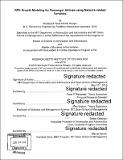| dc.contributor.advisor | Peter Belobaba and Roy Welsch. | en_US |
| dc.contributor.author | Molina Realpe, Norányeli Paola. | en_US |
| dc.contributor.other | Sloan School of Management. | en_US |
| dc.contributor.other | Massachusetts Institute of Technology. Department of Aeronautics and Astronautics. | en_US |
| dc.contributor.other | Leaders for Global Operations Program. | en_US |
| dc.date.accessioned | 2019-10-11T22:24:25Z | |
| dc.date.available | 2019-10-11T22:24:25Z | |
| dc.date.copyright | 2019 | en_US |
| dc.date.issued | 2019 | en_US |
| dc.date.issued | 2019 | en_US |
| dc.identifier.uri | https://hdl.handle.net/1721.1/122578 | |
| dc.description | Thesis: M.B.A., Massachusetts Institute of Technology, Sloan School of Management, 2019, In conjunction with the Leaders for Global Operations Program at MIT | en_US |
| dc.description | Thesis: S.M., Massachusetts Institute of Technology, Department of Aeronautics and Astronautics, 2019, In conjunction with the Leaders for Global Operations Program at MIT | en_US |
| dc.description | Cataloged from PDF version of thesis. | en_US |
| dc.description | Includes bibliographical references (pages 100-107). | en_US |
| dc.description.abstract | On average, an airline starts to place orders or aircraft within 3 - 10 years before the expected delivery date. During this time, there could be changes given the natural response of the airlines to continuously refine their fleet plan. This behavior implies many possible scenarios that aircraft manufacturers would like to understand and predict in order to improve their backlog management initiatives. Furthermore, demand estimation is always a powerful lever in any production system because it allows the manufacturer to be prepared to address the customer's needs. An airline's network and fleet are dependent on each other. The network is highly dependent on the capabilities of the available fleet but also, the fleet is built considering the network strategy of an airline. Giving this relationship this project aims to develop a set of predictive models based on network-related variables that allow to forecast the RPK growth of an airline in the following 7 years. Most of the available forecast for air passenger traffic focus on economic variables such as fuel price, GDP of the countries, trade index and population among others. This project wanted to explore if network variables had any relationship with future RPKs for an airline. After the analysis of historical data of more than 400 carriers from 2010 to 2017, the results show that although mild, there is an influence of these variables and we could use the resulting forecast with a solid reliability. Furthermore, the final coefficients show more influence of these variables for short-haul (less than 2500 nautical miles) and Economy markets than long-haul and Business markets. For Boeing and its current backlog size of more than 5,800 aircraft [1], the resulting models represent another tool that will aid the company in making data driven decisions regarding aircraft production, new orders to come, evaluation of current and potential customers, and other business analysis. | en_US |
| dc.description.statementofresponsibility | by Norányeli Paola Molina Realpe. | en_US |
| dc.format.extent | 107 pages | en_US |
| dc.language.iso | eng | en_US |
| dc.publisher | Massachusetts Institute of Technology | en_US |
| dc.rights | MIT theses are protected by copyright. They may be viewed, downloaded, or printed from this source but further reproduction or distribution in any format is prohibited without written permission. | en_US |
| dc.rights.uri | http://dspace.mit.edu/handle/1721.1/7582 | en_US |
| dc.subject | Sloan School of Management. | en_US |
| dc.subject | Aeronautics and Astronautics. | en_US |
| dc.subject | Leaders for Global Operations Program. | en_US |
| dc.title | RPK growth modeling for passenger airlines using network-related variables | en_US |
| dc.title.alternative | Revenue Passenger Kilometres growth modeling for passenger airlines using network-related variables | en_US |
| dc.type | Thesis | en_US |
| dc.description.degree | M.B.A. | en_US |
| dc.description.degree | S.M. | en_US |
| dc.contributor.department | Sloan School of Management | en_US |
| dc.contributor.department | Massachusetts Institute of Technology. Department of Aeronautics and Astronautics | en_US |
| dc.contributor.department | Leaders for Global Operations Program | en_US |
| dc.identifier.oclc | 1119388598 | en_US |
| dc.description.collection | M.B.A. Massachusetts Institute of Technology, Sloan School of Management | en_US |
| dc.description.collection | S.M. Massachusetts Institute of Technology, Department of Aeronautics and Astronautics | en_US |
| dspace.imported | 2019-10-11T22:24:24Z | en_US |
| mit.thesis.degree | Master | en_US |
| mit.thesis.department | Sloan | en_US |
| mit.thesis.department | Aero | en_US |
